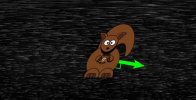Spacetime is definitely a thing...
It's definitely not a thing.
Spacetime is definitely a thing...
I'm almost certain there's a hilarious movie character goes by "Bubbles" and I wanted to post a photo here but you can't do character name searches anymore on IMDB and that just sucks. There was Dobie Gillis's highschool ex and god I might actually have seen that air, but that isn't it, also there's this you might be interested in, Bubble Trouble "An invasion of alien bubbles causes wacky behavior" sounds like a winner there, and there's a Bubbles character in The Wire but I never watched that. Oh well, enough troubling with bubbles, they are very cool but also the cause of a lot of financial ruin, tulips anyone? Maybe prefer collateralized debt obligations? I'm really POed they killed character search.Actually, its simply the geometry of the surface of the liquid in which the bubbles float. Put water in a glass, for example, and the water curves up (the meniscus) where it is in contact with the glass sides - it makes a shallow half-pipe curve. When you float an object in that liquid, despite you not being able to see it, the curve of the liquid and the surface tension pulls the floating things (which are experiencing little friction) towards each other. This is compounded by other facts, such as that surface tension being depressed by the mass of the floating object (even a bubble) and the depression thereby sucking in close objects or in turn being pulled into the depression formed by those objects.
So while gravitation is affecting the bubbles, it's actually the world of surface tension which has greater dominion on this scale. As a human, you notice gravity but barely ever notice surface tension. If you were an insect, this would be reversed and your sensory world would be dominated more by surface tension than by gravity.
It's exactly not the same at all; space isn't a medium like liquid - it's absent a medium.
Well, gravity is depressing the fluid, and objects in the fluid are more strongly attracted to the more massive (contains more moles) liquid than to the
atmosphere, and the objects do create a depression in that surface because gravity is pulling those objects down against the resistance of the liquid.
But in space, objects aren't experiencing any resistance from the medium they're in because space is not a medium in that sense.
It doesn't at our level of apprehension, but gravitationally it has a topology. You can't see it, but there are troughs and peaks all the same.
Because it actually does, just not a visual topology as we'd be accustomed to imagine because it's not a thing.
There's not: just a region of less dense plasma, else photons wouldn't be able to escape.
Again, space isn't a thing, so it's unable to possess attributes like these.
You won't hear any complaints from me. Having ideas like this, whether they're right or wrong, is about curiosity and wonder. Personally, I find bubbles to be an infinite source of speculative imagination for me. Everything about bubbles hints to me at tantalizing clues to understand a lot of the structure of nature - like for example the way a clump of bubbles together compress each other into hexagonal shapes. Absent any other pressures, bubbles will naturally form into spheres - the smallest possible surface area for the contained volume. Whereas multiple bubbles in contact form shared walls, gravitay forces now causes the bubbles to minimize the surface area incorporating that shared wall, and bubbles will therefore fall into the most efficient shape in that configuration which is a hexagon - look at 3 bubbles in contact with each other and their shared walls will always be at 120 degree angle from each other.
It's some deep shit - the structuralizing forces of the universe, the actual produced shape of the fabric of the universe, sitting right there in your bathtub.
To me, this youtube channel is among the best that explains relativity in the simplest manner.
Here are the key videos that are most relevant to your question
